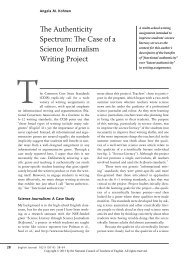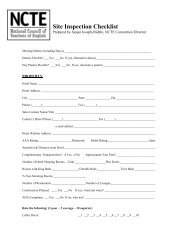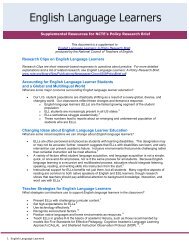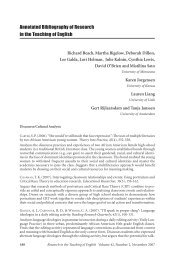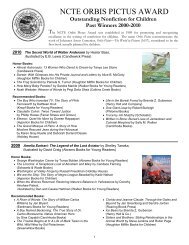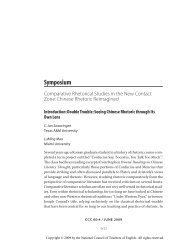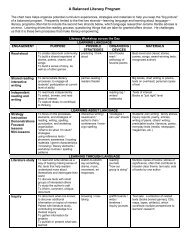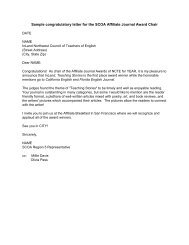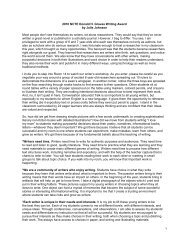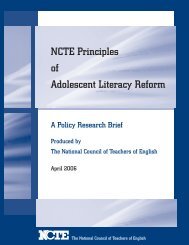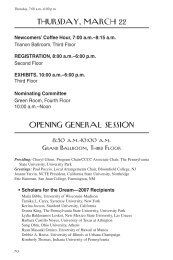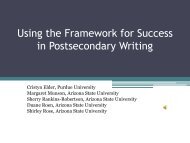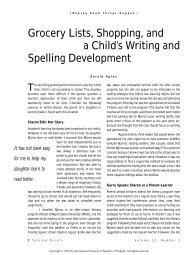Annotated Bibliography of Research in the Teaching of English
Annotated Bibliography of Research in the Teaching of English
Annotated Bibliography of Research in the Teaching of English
- No tags were found...
Create successful ePaper yourself
Turn your PDF publications into a flip-book with our unique Google optimized e-Paper software.
210 <strong>Research</strong> <strong>in</strong> <strong>the</strong> Teach<strong>in</strong>g <strong>of</strong> <strong>English</strong> Volume 41 November 2006method and <strong>the</strong>ory. F<strong>in</strong>d<strong>in</strong>gs show that def<strong>in</strong>itions <strong>of</strong> CDA and <strong>the</strong>ories <strong>of</strong> language underly<strong>in</strong>g<strong>the</strong> studies are multifarious, methods are rarely del<strong>in</strong>eated, and research contexts are <strong>in</strong>tegralto <strong>the</strong> empirical studies. The review demonstrates that educational researchers arereconceptualiz<strong>in</strong>g CDA for <strong>the</strong>ir purposes <strong>in</strong> educational contexts.SCHULTZ, K., BUCK, P., & NIESZ, T. (2005). Author<strong>in</strong>g “race”: Writ<strong>in</strong>g truth and fiction after school.Urban Review: Issues and Ideas <strong>in</strong> Public Education, 37(5), 469-489.Exam<strong>in</strong>es <strong>the</strong> writ<strong>in</strong>g and conversations <strong>of</strong> a diverse group <strong>of</strong> 8th grade students who attend avoluntary after-school writ<strong>in</strong>g group where <strong>the</strong>y discuss and write about race relations at <strong>the</strong>irdesegregated school. Conflat<strong>in</strong>g racism with race talk, <strong>the</strong> students were comfortable writ<strong>in</strong>gfiction about racism <strong>in</strong> school life but not <strong>in</strong> represent<strong>in</strong>g <strong>the</strong>ir school as a place where race wasa subject <strong>of</strong> discussion or action. F<strong>in</strong>d<strong>in</strong>gs suggest <strong>the</strong> importance <strong>of</strong> educators listen<strong>in</strong>g carefullyto young people’s understand<strong>in</strong>gs <strong>of</strong> race and help<strong>in</strong>g <strong>the</strong>m to dist<strong>in</strong>guish between talkabout race and racist talk.O<strong>the</strong>r Related <strong>Research</strong>:ANGGARD, E. (2005). Barbie pr<strong>in</strong>cesses and d<strong>in</strong>osaur dragons: Narration as a way <strong>of</strong> do<strong>in</strong>g gender.Gender and Education, 17(5), 539-553.ARBER, R. (2005). Speak<strong>in</strong>g <strong>of</strong> race and ethnic identities: Explor<strong>in</strong>g multicultural curricula. Journal<strong>of</strong> Curriculum Studies, 37(6), 633-652.BARTLETT, L. (2005). Dialogue, knowledge, and teacher-student relations: Freirean pedagogy <strong>in</strong><strong>the</strong>ory and practice. Comparative Education Review, 49(3), 344-364.BLAISE, M. (2005). A fem<strong>in</strong>ist poststructuralist study <strong>of</strong> children “do<strong>in</strong>g” gender <strong>in</strong> an urbank<strong>in</strong>dergarten classroom. Early Childhood <strong>Research</strong> Quarterly, 20(1), 85-108.CONRAD, D. (2005). Reth<strong>in</strong>k<strong>in</strong>g “at-risk” <strong>in</strong> drama education: Beyond prescribed roles. <strong>Research</strong><strong>in</strong> Drama Education, 10(1), 27-41.DAVIS, J. (2006). <strong>Research</strong> at <strong>the</strong> marg<strong>in</strong>: Mapp<strong>in</strong>g mascul<strong>in</strong>ity and mobility <strong>of</strong> African-Americanhigh school dropouts. International Journal <strong>of</strong> Qualitative Studies <strong>in</strong> Education, 19(3), 289-304.DE FINA, A., SCHIFFRIN, D., & BAMBERG, M. (EDS.). (2006). Discourse and identity. New York: CambridgeUniversity Press.ENGLISH, L. (2005). Narrative research and fem<strong>in</strong>ist know<strong>in</strong>g: A poststructural read<strong>in</strong>g <strong>of</strong> women’slearn<strong>in</strong>g <strong>in</strong> community organizations. McGill Journal <strong>of</strong> Education, 40(1), 143-155.ERIKSSON, K., & ARONSSON, K. (2005). “We’re really lucky”: Co-creat<strong>in</strong>g “us” and <strong>the</strong> “o<strong>the</strong>r” <strong>in</strong>school booktalk. Discourse & Society, 16(5), 719-738.EVALDSSON, A. (2005). Stag<strong>in</strong>g <strong>in</strong>sults and mobiliz<strong>in</strong>g categorizations <strong>in</strong> a multiethnic peer group.Discourse & Society, 16(6), 763-786.FATAAR, A. (2005). Discourse, differentiation and agency: Muslim community schools <strong>in</strong> postapar<strong>the</strong>idCape Town. Comparative Education Review, 49(1), 23-44.FISHMAN, S., & MCCARTHY, L. (2005). Talk about race: When students’ stories and multiculturalcurricula are not enough. Race, Ethnicity & Education, 8(4), 347-364.FRANCIS, B. (2006). Heroes or zeroes? The discursive position<strong>in</strong>g <strong>of</strong> “underachiev<strong>in</strong>g boys” <strong>in</strong><strong>English</strong> neo-liberal education policy. Journal <strong>of</strong> Education Policy, 21(2), 187-200.GEORGAKOPOULOU, A. (2006). The o<strong>the</strong>r side <strong>of</strong> <strong>the</strong> story: Towards a narrative analysis <strong>of</strong> narratives-<strong>in</strong>-<strong>in</strong>teraction.Discourse Studies, 8(2), 235-257.HYLAND, N. (2005). Be<strong>in</strong>g a good teacher <strong>of</strong> Black students? White teachers and un<strong>in</strong>tentionalracism. Curriculum Inquiry, 35(4), 429-459.JOHNSON, G., CLARKE, S., & DEMPSTER, N. (2005). The discursive (re)construction <strong>of</strong> parents <strong>in</strong>school texts. Language and Education, 19(5), 380-399.



